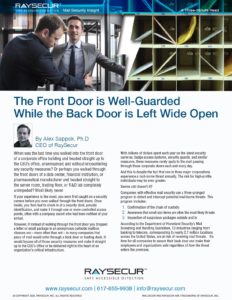When was the last time you walked into a corporate office building and headed straight up to the CEO’s office, unannounced and without any security measures?
Or perhaps you walked through the front doors of a data center, financial institution, or pharmaceutical manufacturer and headed straight to the server room, trading floor, or R&D lab completely unimpeded?
Most likely never.
If your experience is like most, you were first caught on a security camera before you even walked through the front doors.
Once inside, you then had to check in at a security desk, provide identification, and make it through one or more controlled access points, often with a company escort who had been notified of your arrival.
However, if instead of walking through the front door you dropped a letter or small package in an anonymous curbside mailbox, chances are – more often than not – in many companies that piece of mail would enter through a back door or loading dock.
 It would bypass all of those security measures and make it straight up to the CEO’s office or be delivered right to the heart of an organization’s critical infrastructure.
It would bypass all of those security measures and make it straight up to the CEO’s office or be delivered right to the heart of an organization’s critical infrastructure.
With billions of dollars spent each year on the latest security cameras, badge access systems, security guards, and similar measures, these measures rarely apply to the mail passing through those corporate doors each and every day.
And this is despite the fact that one in three major corporations experience a mail-borne threat annually. The risk for high-profile individuals may be even greater.
Seems odd doesn’t it?
Companies with effective mail security use a three-pronged program to detect and intercept potential mail-borne threats. This program includes:
- Confirmation of the chain of custody
- Awareness that small size items are often the most likely threats
- Inspection of suspicious packages outside and in
According to the Department of Homeland Security’s Mail Screening and Handling Guidelines, 13 industries ranging from banking to telecom, corresponding to nearly 2.7 million locations across the United States, are at risk of receiving mail threats.
It’s time for all companies to secure their back door and make their employees and organizations safe regardless of how the threat enters the premises.
